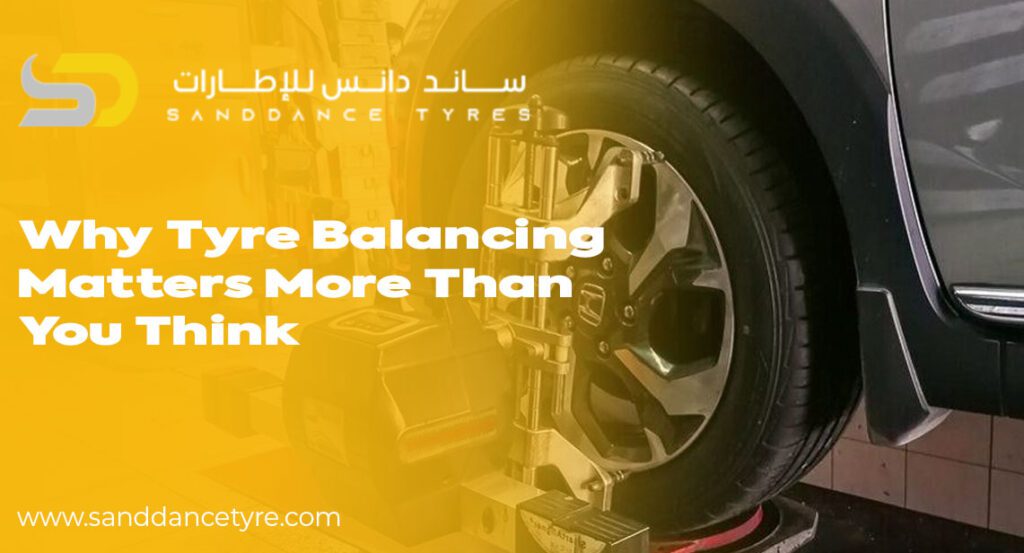In the UAE, we see that many drivers pay attention to tire pressure, alignment, and rotation when it comes to the care of their tires, which also means they often pay little attention to tire balancing. But in fact, what we have found is that unbalanced tires play a large role in how your car drives, in the performance of your vehicle, and even in terms of long-term safety. We see that if you understand the importance of tire balancing, which may not be at the front of your mind, it can help you avoid common issues like vibration, uneven wear, and steering problems. Also, it is not just for a better ride; tire balance is a very important aspect of your vehicle’s health.
What is Tyre Balancing and How Does it Work?
Tyre balancing is a process which sees to it that ensures a tyre and wheel assembly’s weight is distributed evenly around the axle. What we must note is that even the best manufacturing processes can produce minute weight variances in the wheels or tyres. In our balancing procedure, we put on small weights at the wheel rim, which in turn correct any imbalances. This is to say that as the tyre rotates, it does so smoothly without play or wobble. Well-balanced tyres, in turn, reduce vibration and also improve the life of the tyres and suspension components.
Signs Your Tyres May Be Out of Balance
One of the early indicators of unbalanced tires is that you will notice a vibration in the steering wheel or seat, which is more pronounced at higher speeds. That vibration is a result of uneven weight distribution, which in turn causes the tire to very slightly bounce as it spins. Also, you may see atypical tire wear patterns, reduced fuel efficiency, and put extra strain on your suspension. In the U.A.E., which has a lot of highways and long-distance travel, these issues can become at once irritating and also, in some cases, dangerous if left unattended.
The Relationship Between Tyre Balancing and Ride Comfort
A good quality balance in your tires improves ride comfort which in turn reduces that which is not needed for vibration and road noise. This is very true for drivers in the UAE who do a great deal of highway and off-road travel. Also, when tires are not balanced properly, the total driving experience is rough and noisy. Over time, that vibration can lead to driver fatigue and also diminish the pleasure of driving. For long trips or daily commutes, balanced tires do make a difference in comfort and control.
Impact of Tyre Balancing on Tyre Longevity
Tyre wear issues are a result of balance problems. An unbalanced tyre puts more pressure and wear on certain areas than others. This causes uneven wear, which in turn reduces tyre life. You may find yourself going through tires more quickly than you should. By having regular tyre balancing, we see even wear across the board, which in turn preserves the tread and improves overall tyre wear. Also, you will see a reduced risk of premature failure or sidewall damage.
How Tyre Balancing Helps Fix Vibration Issues
If your vehicle is experiencing vibration at certain speeds and not at others, it is very likely that your tires are out of balance. What we see is that an unbalanced tire will oscillate as it spins, which in turn sends shock waves through the steering system or chassis. At the professional level, we have wheel balance, which corrects for this by making sure the tire rotates evenly. In the UAE, we see that drivers report smoother handling and improved road stability right away after balancing, which is very noticeable, especially when you are on long stretches like Sheikh Zayed Road.
Tyre Balancing vs. Wheel Alignment: What’s the Difference?
Many drivers mix up what is done at the time of tyre balancing and wheel alignment. While both services are very important, they are for different issues. With wheel alignment, we look at the angle of your wheels, which we set to run true, which in turn will reduce steering drift and improve handling. In case of tyre balancing, we are looking at the weight distribution within the wheel and tyre assembly. Although both play a role in overall vehicle stability and wear of parts out they approach different issues.
When Should You Get Your Tyres Balanced?
Ideally, every 10,000 to 12,000 km or at each tire rotation, we should get the tires balanced. Should you notice vibration or changes in fuel economy, or find that the tire treads out unevenly, take care of it right away. Here in the UAE, we see that road and weather conditions are hard on tires, so do include tire balance in your regular care. Also, if you have new tires put on, or have a repair done, or run over a pothole, head in for a tire balance check.
Professional Tyre Balancing Services in the UAE
Not all balancing services are the same. At Sanddance Tyres, we have at our disposal very advanced computer-assisted balancers which we use to identify even the tiniest of tyre weight issues. Our team then takes care of each tyre’s correction, which in turn improves performance, safety, and comfort. No matter if you are driving a sedan, an SUV, or a 4×4, we put tire balance forward as a key element of our tire care advice. A few grams of imbalance may appear a trivial issue — but in actuality, they play a large role in what you feel while you are behind the wheel.
Bottom Line
Tyre balance is an often-overlooked issue by most drivers. It improves ride quality and also increases tyre life, which in turn improves performance and reduces wear. In a country like the UAE, which has hot roads and high speeds daily, a proper balance is a must. At Sanddance Tyres, we do precise balancing, which in turn gives you a smooth and stress-free drive. Don’t wait until you have a vibration issue to bring your car in; make tyre balancing a routine.
Read More: When to Buy Specialty Tyres: Mud‑Terrain vs. All‑Terrain
Frequently Asked Questions About Tyre Balancing
What will happen if I drive on unbalanced tires?
Driving with unaligned tires causes vibration, irregular tire wear, decreased fuel efficiency, and extra stress on suspension elements. In time, this may lead to more serious mechanical issues.
How frequently should tire balancing take place?
It is advised that you get your tires balanced at 10,000 to 12,000 km and also when you rotate your tires. Also, tire balancing is required at the time of installation of new tires or after hitting a pothole.
Can tyre balancing improve fuel economy?
Yes, with balanced tires we see a reduction in rolling resistance and thus the car runs more efficiently, which in turn may see an improvement in fuel economy over time.
Is there a difference between tyre balancing and wheel alignment?
Yes, in tyre balancing we look at weight distribution within the tyre and wheel assembly, at the same time alignment looks at the proper angle and alignment of the wheels to the vehicle’s suspension.
What does tire balancing do for all vibration issues?
Not usually. Though tyre balance is a fix for many vibration issues, it is also true that misaligned wheels, worn out suspension parts, or bent rims play a role, which in turn will require a different diagnosis.















